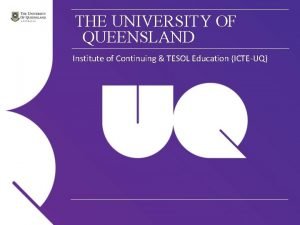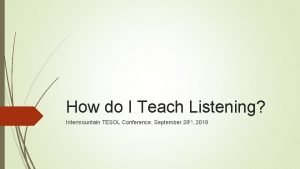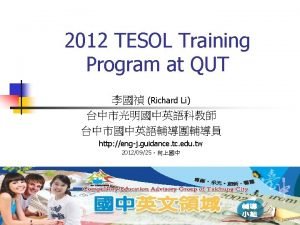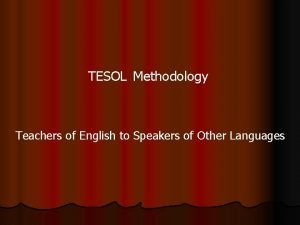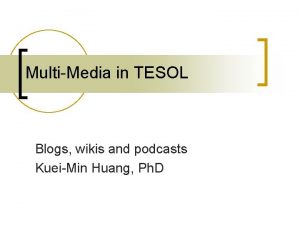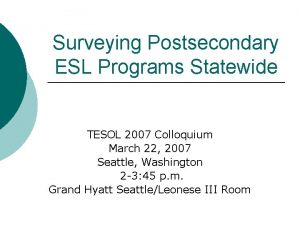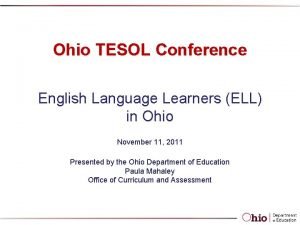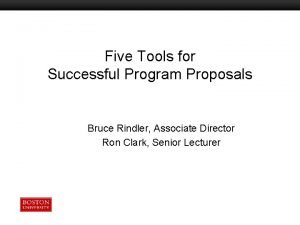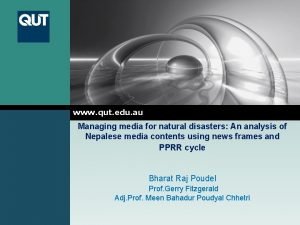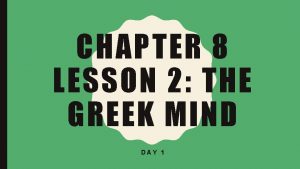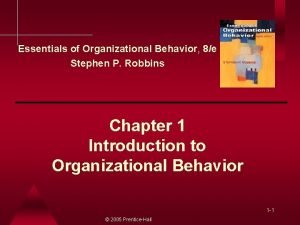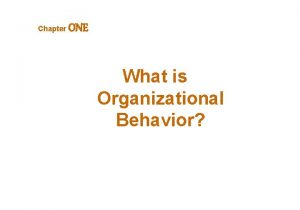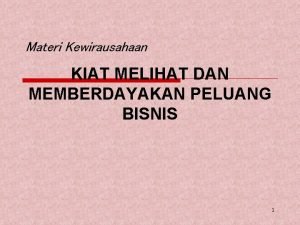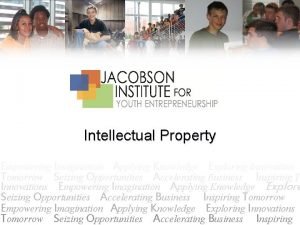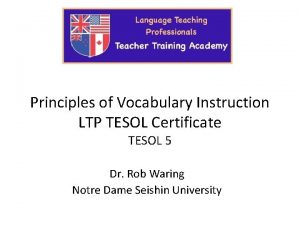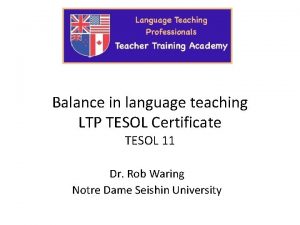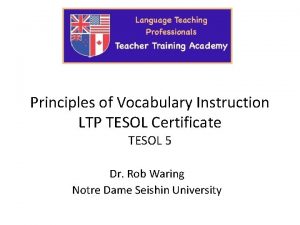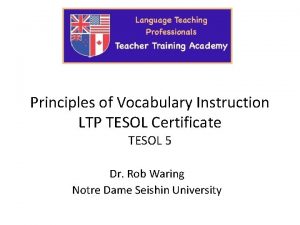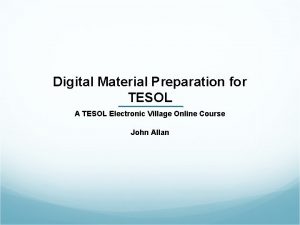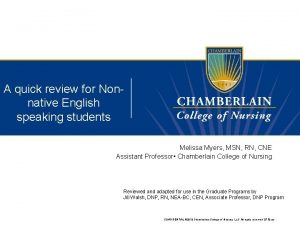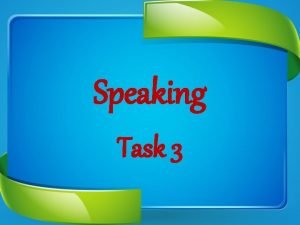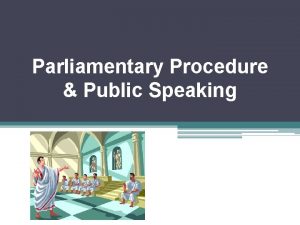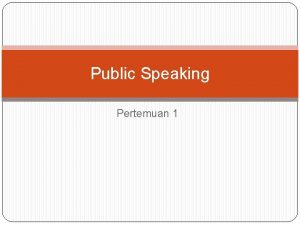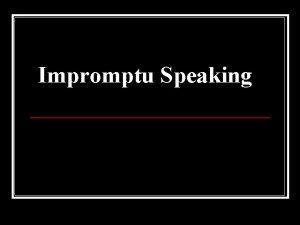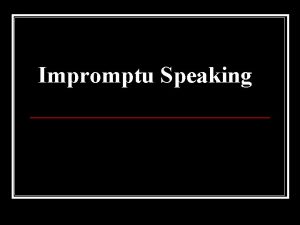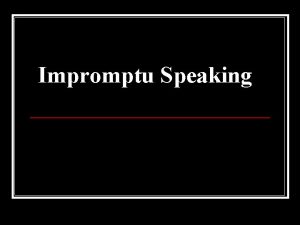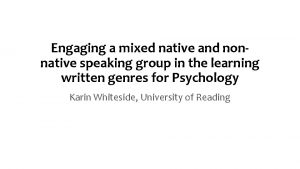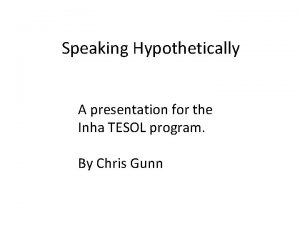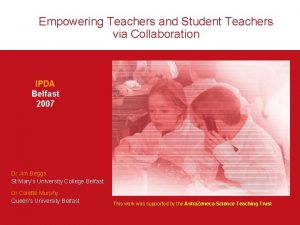Empowering Nonnative English Speaking Teachers in TESOL Dr






















- Slides: 22

Empowering Nonnative English Speaking Teachers in TESOL Dr. Jun Liu University of Arizona Nov. 24, 2009 The National Seminar, CULI

Native/Nonnative Debate n n n n Linguistic (reliable source of linguistic data, Chomsky, 1965) Biological/environmental (Liu, 2001) Sociolinguistic (proficient user, Paikeday, 1985; expert speaker, Rampton, 1990) Social recognition/identity (judgment of speakers’ accent, Davies, 1991, 2003) Self-identity (China English, Liu, 1999, Norton, 2004) Dichotomy vs. continuum (Higgins, 2003) Global English: Functional Nativeness (Graddol, 2006) English (non-)nativeness in World Englishes framework (Kachru, 1981, Moussu & Ilurda, 2008)

Challenges in teacher training: NES versus NNEST n n n Different population Different sets of strengths and weaknesses Different strategies and training models Different goals and objectives Different mindset and evaluation standards

Strengths of NNESTs n Strengths of NNESTs (1) provide a good learner model for imitation, (2) teach language learning strategies more effectively, (3) supply learners with more information about the English language, (4) anticipate and prevent language difficulties better, (5) be more empathetic to the needs and problems of learners, and (6) make use of the learners’ mother tongue.

Weaknesses of NNESTs n n n n Lack of native intuition to the language Lack of authentic input Lack of cultural richness and contextual clues Short of improvisational skills Weak at colloquial and idiomatic expressions Constrained by the school curriculum Burning candles at both ends, lacking professional development opportunities Lack of collegial atmosphere, language environment, and supportive system

Complexities n n n n Dichotomy vs. continuum Co-constructed identities New framework of communicative competence Global vs. local contexts Inferiority vs. superiority complex Multilingualism & multiculturalism Focus on professional training

Formats of English teacher development n n n Workshops (credit-bearing, intensive) Certificate (university courses, TESOL certificate programs) Professional Development (Conferences, symposia, forums, debate, newsletters, on-line resources, colloquia, publications) Performance-based contractual hiring system (The weight of student evaluation, external review, annual report and self-evaluation) Tenure-track, program specialists, part-timers

English teacher development in EIL contexts n n n The bottom-line: Language proficiency The depth of teaching: Content/cultural knowledge Redefining the concept of research Skills Development: Teaching approaches and methods Investment: Affective factors Critical thinking: Why we do what we do

Drawbacks of our teacher training in EIL contexts n n n Visiting English-speaking countries might not be a worthy investment Holding big conferences does not solve the problem Experts’ lectures do not have long-term impact General topics do not provide depth Open classes only serve as showcase Face-saving does not resolve the hidden problem

New perspectives on English teacher training in EIL contexts n n n n n Set up clear and attainable objectives for teacher training Raise the bar foreign teacher hire and utilize foreign resources Have small-scale, theme-based, and level-specific training program Implement teacher certificate programs at provincial and national levels Utilize on-line resources and expertise of core teacher trainers Focus on the on-going development of communicative competence Invest in sister schools and universities with foreign countries Strengthen pre-service training programs while providing objective evaluative supervision mechanism Change the concept: Teach English, not teach about English

Ten dimensions of English teacher training in EIL Contexts

1. Training on linguistic knowledge Goal: Teachers demonstrate knowledge of the nature of human language and the phonological, morphological, lexical/semantic, and syntactic systems of English and are able to describe the similarities and differences between English and the mother tongue in these areas.

2. Training on English Proficiency Goal: Teachers demonstrate adequate oral and written proficiency in social and academic English.

3. Training on language processes and strategies n Goal: Teachers understand the nature of human language and the psycholinguistic and sociolinguistic processes and factors involved in native and non-native language acquisition and use.

4. Training on cultural and intercultural communication skills n Goal: Teachers understand the nature of language and culture and communicative styles and skills in various intercultural communication contexts.

5. Training on pedagogical knowledge and teaching methodology n Goal: Teachers are familiar with various methods for and approaches to teaching English as a foreign language. They are also familiar with basic principles of teaching and learning languages.

6. Training on curriculum development and syllabus design n Goal: Teachers demonstrate adequate skills in designing and implementing effective materials and learning tasks and activities in the classrooms

7. Training on knowledge and skills in technology n Goal: Teachers demonstrate familiarity with and application of technology in teaching

8. Training on testing and assessment n Goal: Teachers demonstrate their understanding of the validity and reliability of tests.

9. Training on professional development n Goal: Teachers stay current on research, trends, policies, and legal mandates on TESOL, TEFL, ELT, or EIL programs.

10. Training on research n Goal: Teachers demonstrate their knowledge of both qualitative and quantitative research methods and know they can use these methods to reflect their teaching and improve their classroom practice.

Where shall we begin? n. TESOL
 Kim kroll teachers pay teachers
Kim kroll teachers pay teachers Uq eap
Uq eap Intermountain tesol
Intermountain tesol Tesol course qut
Tesol course qut Roughly tuned input
Roughly tuned input Tesol wiki
Tesol wiki Ucsb extension tesol
Ucsb extension tesol Ohio tesol
Ohio tesol Boston university tesol
Boston university tesol Www qut edu au
Www qut edu au Greek theatre mind map
Greek theatre mind map Quotes about empowering youth
Quotes about empowering youth Empowering people in ob
Empowering people in ob Empowering people in ob
Empowering people in ob Empowering people in ob
Empowering people in ob Empowering and delegating
Empowering and delegating Empowering people acer
Empowering people acer Empowering minds curriculum
Empowering minds curriculum Bagaimana pemberdayaan peluang usaha yang baik
Bagaimana pemberdayaan peluang usaha yang baik Empowering imagination
Empowering imagination Filipino advocacy using ict
Filipino advocacy using ict Social work: an empowering profession 9th edition chapter 1
Social work: an empowering profession 9th edition chapter 1 Empowerment delegation
Empowerment delegation

